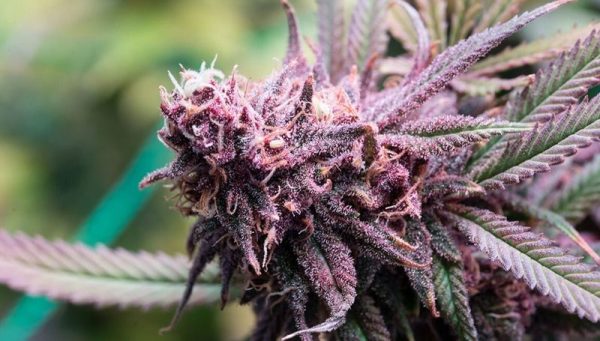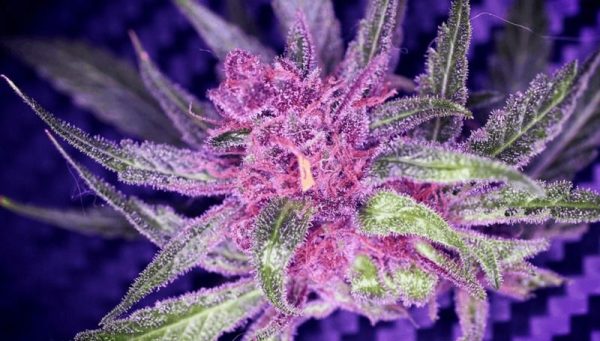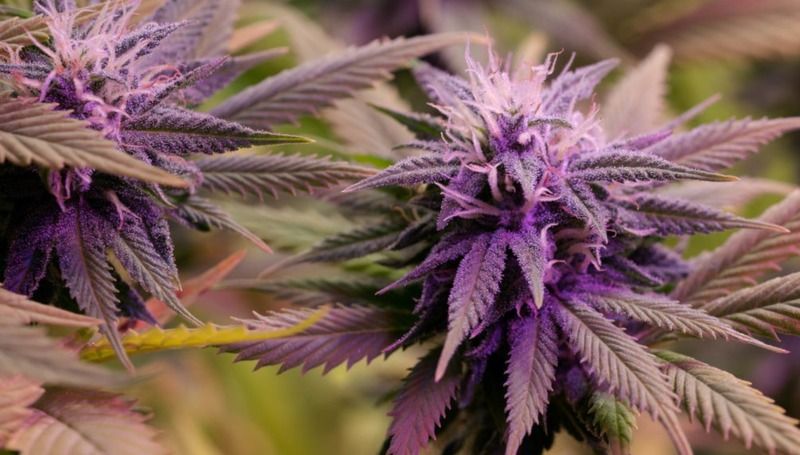The leaves of certain marijuana strains turn purple due to a haut amount of anthocyanins, which are pigment molecules. Anthocyanins are water-soluble natural pigments found in many plants. They’re the component that gives blueberries their color, as well as blackberries and red grapes. You can buy more products in our boutique.
Anthocyanins are also found in cannabis plants. These pigment molecules give the variety of hues seen in buds from different strains of cannabis.
The pigment in cannabis is called anthocyanin. It comes in a variety of colors, including red, gold, dark green, blue, and black. The hue of cannabis is determined by the plant’s genetics and cultivation techniques. Many factors influence the color and durability of anthocyanin pigments, including temperature, light, pH level, and structure.
Cannabis leaves can change color as the plant matures, just as leaves do in the fall. If you think of a cannabis crop growing in nature, this would also happen during the fall when the temperature drops and the nights grow longer.

Certain strains have naturally high amounts of anthocyanins. Certain situations, such as entering the “winter” cycle of bloom, expose these strains’ stunning purple tints. This is a natural result of a plant’s genotype and external environmental conditions interacting.
What are Anthocyanins?
Anthocyanins are a group of phytochemicals that fall under the flavonoid category. Flavonoids are a class of plant chemicals found in fruits, vegetables, grains, teas, and nuts. They’re also present in cannabis plants alongside two additional kinds of compounds: cannabinoids and terpenes.
Anthocyanins are also believed to have health advantages, including enhancing eye and cognitive health. “Scientific research, such as cell culture studies, animal models, and human clinical trials, show that anthocyanidins and anthocyanins have antioxidant and antibacterial properties that improve visual and neurological health while also protecting against various non-communicable diseases,” according to Khoo et al.
Anthocyanins, as well as other flavonoids, have been found to have anti-inflammatory and antioxidant properties. Anthocyanins may provide a plethora of advantages. They might help protect the heart and liver while also aiding in weight loss and diabetes prevention.
Plants with high anthocyanin content have been utilized as herbal medicines for thousands of years. In the past, ancient civilizations from North America, Europe, and China used these naturally occurring treatments.
Is purple grass healthier than green marijuana, then? Unfortunately, probably not. The majority of anthocyanins are absorbed through the digestive system. As a result, to observe any significant variation, you’d have to eat a lot of edibles. Probably not an excellent option!
Are Purple Strains Healthier?
The antioxidant content of purple cannabis flowers is higher. You’d need to consume a significant number of buds in order to get any advantage from their antioxidants. Not advised!
Purple plants do tend to have lower amounts of THC, although high-THC purple strains are possible to grow. According on seasoned breeder Matt Gosling, the purple strains available for purchase in dispensaries are the result of excellent genetics rather than stress. Consumers recall purple strains. However, Gosling warns that attempting to breed a plant with a more intense purple pigment might actually damage its quality in terms of potency and medicinal effects.
Myths
- Stressing A Strain Will Turn It Purple
Cannabis leaves are sometimes said to turn purple if the plant isn’t given enough nutrients for growth. Potassium, phosphorus, oxygen, carbon dioxide, and nitrogen are among them. In fact, withholding food from them would cause the plants to die.
- Freezing A Strain Will Turn It Purple
It is not suggested that cannabis plants be subjected to flash freezing or ice water flushes. It can both reduce the THC content and kill the plants. Finally, this notion is preposterous, and I’m unsure how anyone could believe it, but….
- You Can Dye Your Cannabis Purple With Food Coloring
Obviously, this would be a waste of time and resources, so I’d want to know who came up with it.
How do Anthocyanins Affect Plant Appearance?
Anthocyanins are only produced for the last few weeks of a plant’s life, and they only start to change its appearance at the end. The lack of chlorophyll in the final stages allows the pigments to shine through even more clearly.

As days grow shorter and nights longer, photoperiod-dependent plants are given the signal to cease producing chlorophyll (which is required for photosynthesis and vegetative growth) so that energy may be focused entirely on developing flowers and, eventually, fruits. As chlorophyll is broken down and dissipates from the plant’s structures, and anthocyanins accumulate, the plant takes on vivid purple, blue, and red hues.
Cannabis plants that have low amounts of anthocyanins are frequently colored at the end of the flowering cycle. Most growers will be familiar with the gold, orange, and ochre hues that appear in many cannabis strains prior to harvest—and while yellowing in the vegetative period or early flowering is generally a sign of illness or deficiency, it is entirely natural during later floral phases.
In this scenario, the carotenoids are responsible, a family of approximately 600 molecules that vary in color from pale yellow to deep orange-red. As carotenoids are formed throughout the plant’s life cycle, their presence in the final stages of growth is caused by chlorophyll reduction rather than an increase in pigment formation.
Maximum Yield Explains Purple Cannabis
Anthocyanins are water-soluble pigments found in a variety of plants, and their phenotypic manifestation can vary from purple to red to dark blue or black depending on the pH.
The purple color of a cannabis plant is due to a variety of factors, including genetics, chemicals, and natural elements. Because higher alkaline soil prevents plants from absorbing anthocyanins, pH levels must be neutral or slightly acid. It is, however, difficult to produce a purple-colored plant without having a genetic propensity towards purpleing.
Cannabis plants’ color change from green to purple can be likened to leaves turning orange in the fall. In the final stages of a cannabis plant’s life cycle, as chlorophyll (the substance that gives plants their green color) evaporates, the purple hues that are often hidden by the green begin to appear. The calyx, pistils, and leaves all have the potential to become purple. The curing process also encourages chlorophyll breakdown in harvested flowers, allowing for greater exposure of purple hues.
Purple cannabis, on the other hand, has no advantages over green marijuana in terms of appearance. In fact, purple marijuana tends to have less THC in average. Granddaddy Purple, Purple Urkle, Grape Ape, and Purple Kush are some well-known purple strains.

